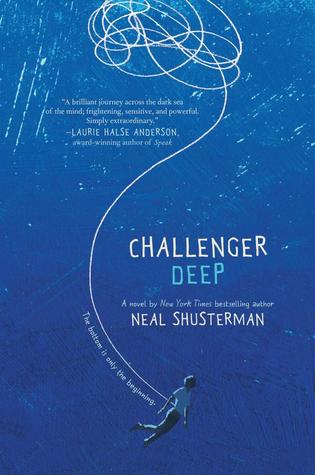 “‘What could have been’ is much more highly regarded than ‘what should have been,’” fifteen-year-old Caden muses. “Dead kids are put on pedestals, but mentally ill kids get hidden under the rug” (168).
“‘What could have been’ is much more highly regarded than ‘what should have been,’” fifteen-year-old Caden muses. “Dead kids are put on pedestals, but mentally ill kids get hidden under the rug” (168).
In Challenger Deep, Neal Shusterman lifts up that rug to tell Caden’s story, using alternating sections set in the real world and the world of his mind. In real life, he’s a high schooler who becomes increasingly paranoid and delusional until he is hospitalized; in his mind, he is part of the crew of a pirate ship on a mission to the Challenger Deep, the deepest point in the ocean. As Caden’s fantasies begin to converge on the real world, he must navigate his competing loyalties and relationships, and try to survive his journey through unknown and dangerous territory.
This book provides insight into the life of a teen struggling with schizophrenia, but unlike many YA books about similar topics, it avoids romanticizing his experience. Caden grapples with intense episodes and personal reflections throughout the book, and Challenger Deep gives readers a glimpse into the surreal, tangled workings of his mind. Shusterman based this book on his son Brendan’s experiences with mental illness, and the book includes drawings by Brendan, which help to give a sense of how Caden sees the world. This makes the book intensely personal, and at times difficult to read. But the challenge is worthwhile: it gives readers, perhaps, a new understanding and compassion for those with mental illnesses, or at the very least a nuanced and moving perspective on a group that is so often marginalized and stereotyped by society.
As Shusterman writes in his author’s note, the honesty of the book may help some to “know that they are not alone.” But people who don’t have experience with mental illness will still find Caden’s story engaging and thought-provoking. It explores universal themes like trust, friendship, and the importance of life. Above all, Shusterman’s book is also a story of determination and tentative hope, of “deep, abiding comfort… to carry [us] through till tomorrow” (308).
Although the parallel settings of Challenger Deep are sometimes confusing, Caden’s nautical journey perfectly symbolizes his real-life turmoil, and illustrates his experiences for readers. Shusterman’s imagery is particularly effective, and there are several truly heartbreaking and harrowing moments, especially in the second half of the book. However, I found the pacing to be a little slow, and I wished that the story could’ve been told in 75 fewer pages. Nonetheless, the brief, insightful chapters helped to make the book seem shorter, and Shusterman’s experiments with perspective, time, and reality provided interest throughout the book. Overall, Challenger Deep is a truthful story of journeys and choices that will appeal to both young people and adults.
By: Anja Hendrikse Liu
Shusterman, Neal. Challenger Deep. New York: HarperTeen, 2015. Print.